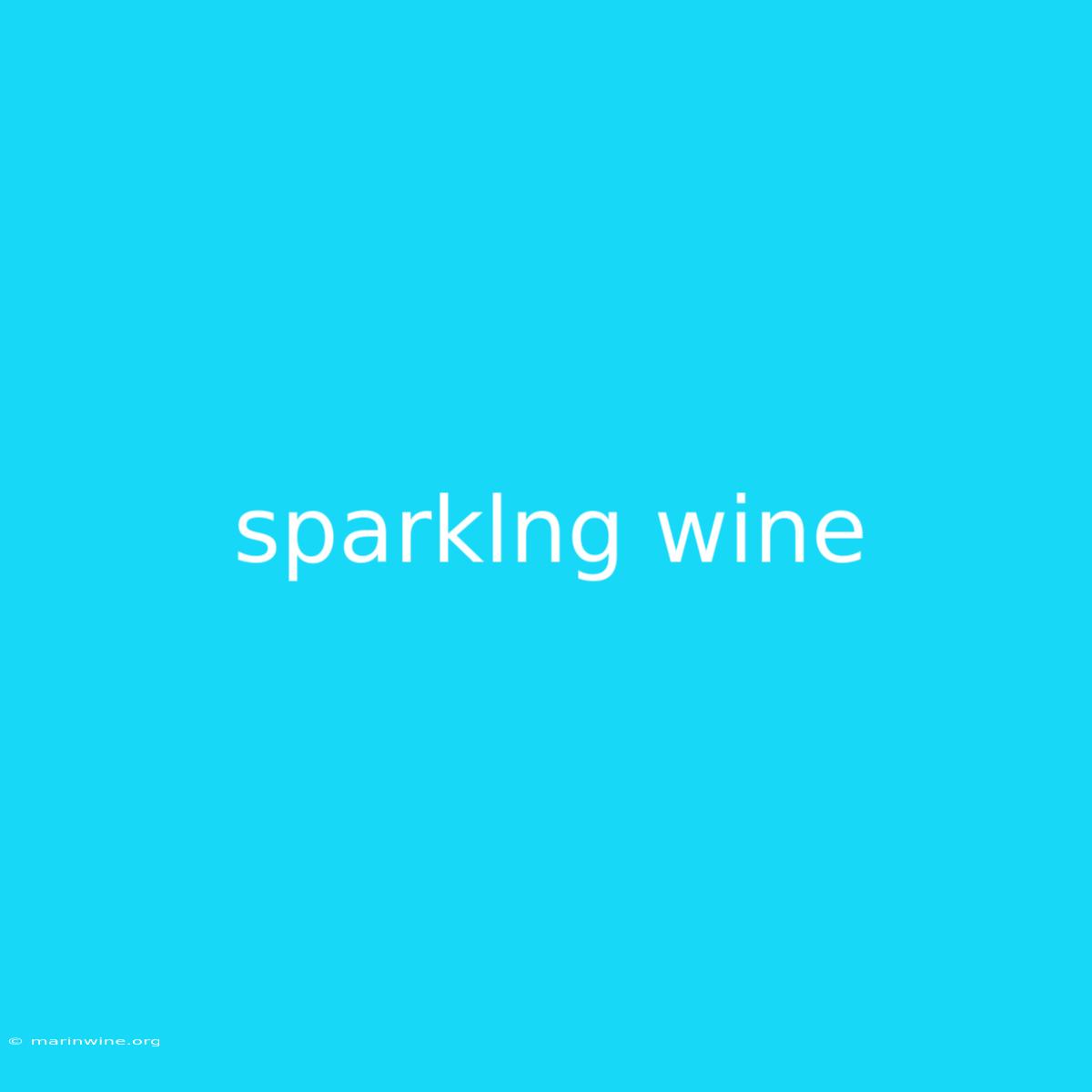Sparkling Wine: More Than Just Champagne! 🥂
Ever wondered what makes sparkling wine so special? It's not just the bubbles, but the complex flavors, history, and production methods that make this beverage a delightful choice for any occasion.
Why Sparkling Wine Matters
Sparkling wine represents a fascinating world of winemaking and a diverse range of styles, from the iconic Champagne to lesser-known but equally captivating regional expressions. Understanding the nuances of sparkling wine can enhance your appreciation of this elegant beverage and expand your wine knowledge.
Key Takeaways of Sparkling Wine:
| Feature | Description |
|---|---|
| Production | A second fermentation process creates the bubbles. |
| Variety | Multiple grape varieties and production methods result in diverse flavors. |
| Regions | Sparkling wines are produced worldwide, each with unique characteristics. |
| Occasions | Celebratory, but also enjoyed as an aperitif or paired with food. |
Sparkling Wine: An Overview
Sparkling wine's allure lies in its effervescence, a result of a secondary fermentation that releases carbon dioxide, creating the sought-after bubbles. While Champagne is the most famous sparkling wine, numerous other regions boast their own unique expressions.
The Sparkling Wine Process
The heart of sparkling wine lies in the méthode champenoise (or traditional method), where a second fermentation occurs within the bottle itself. This method, though labor-intensive, yields the most complex and refined sparkling wines.
Key Aspects of Sparkling Wine:
1. Grape Varieties:
Introduction: Sparkling wine utilizes various grapes, each contributing unique flavor profiles. Facets:
- Chardonnay: Known for its crisp acidity, citrus notes, and aging potential.
- Pinot Noir: Offers red fruit flavors, complexity, and a delicate structure.
- Pinot Meunier: Provides body and fruity notes, often found in blends. Summary: The grape variety significantly influences the taste and character of sparkling wine.
2. Regions:
Introduction: Sparkling wine production extends beyond Champagne, with regions boasting unique styles and regulations. Facets:
- Champagne (France): Known for its elegance, complex aromas, and high acidity.
- Cava (Spain): Often made with the same grape varieties as Champagne, but with a slightly fruitier style.
- Prosecco (Italy): Produced from the Glera grape, known for its light-bodied, floral, and fruity character.
- Crémant (France): Sparkling wines produced in various regions of France, showcasing regional character. Summary: The region of origin impacts the wine's flavor, aroma, and overall style.
3. Pairing with Food:
Introduction: Sparkling wine's versatility extends beyond celebratory occasions. Further Analysis:
- Its acidity balances rich, fatty dishes, while its bubbles cleanse the palate.
- The lighter styles, like Prosecco, complement seafood and salads, while the richer Champagne pairs well with roasted poultry or shellfish. Closing: Understanding the nuances of food pairings enhances the enjoyment of sparkling wine.
Information Table: Popular Sparkling Wine Regions
| Region | Grape Variety | Flavor Profile | Style |
|---|---|---|---|
| Champagne (France) | Chardonnay, Pinot Noir, Pinot Meunier | Complex, elegant, high acidity | Brut, Blanc de Blancs, Blanc de Noirs |
| Cava (Spain) | Macabeo, Xarel-lo, Parellada | Fruity, refreshing, good acidity | Brut, Reserva |
| Prosecco (Italy) | Glera | Floral, fruity, light-bodied | Brut, Extra Dry, Dry |
| Crémant (France) | Various | Regional character, diverse styles | Brut, Rosé, Demi-Sec |
FAQ for Sparkling Wine
Introduction: This section addresses common questions about sparkling wine. Questions:
- Q: What is the difference between Champagne and other sparkling wines? A: Champagne is only produced in the Champagne region of France using the méthode champenoise.
- Q: What is the best way to open a bottle of sparkling wine? A: Use a corkscrew and gently twist the cork while keeping the bottle angled.
- Q: How long can I keep sparkling wine? A: Sparkling wines vary in aging potential, with Champagne being able to age for years.
- Q: How should I serve sparkling wine? A: Serve chilled between 40-45 degrees Fahrenheit.
- Q: Can I drink sparkling wine with food? A: Yes, sparkling wine is a versatile accompaniment for various dishes.
- Q: What is the best way to store sparkling wine? A: Store sparkling wine in a cool, dark place away from direct sunlight. Summary: Understanding these aspects allows for a better appreciation and enjoyment of sparkling wine.
Tips by Sparkling Wine
Introduction: These tips help you elevate your experience with sparkling wine. Tips:
- Choose the right glass: A flute or coupe glass helps preserve the bubbles and aromas.
- Pay attention to the color: The color of the sparkling wine can indicate the grape varieties used and the style.
- Observe the bubbles: Fine, persistent bubbles indicate good quality and freshness.
- Take small sips: This allows you to savor the aromas and flavors.
- Don't be afraid to experiment: Explore different styles and regions to discover your personal preferences. Summary: By following these tips, you can enhance your appreciation of sparkling wine.
Summary by Sparkling Wine
This exploration of sparkling wine revealed its intricate production methods, diverse styles, and versatility. From the iconic Champagne to the lesser-known but equally delicious regional expressions, the world of sparkling wine offers a delightful and enriching experience. Remember, choosing the right sparkling wine for the occasion and pairing it with food enhances the enjoyment of this celebratory beverage.
Closing Message: Next time you reach for a bottle of sparkling wine, take a moment to appreciate the craftsmanship and history that make this beverage so special.

